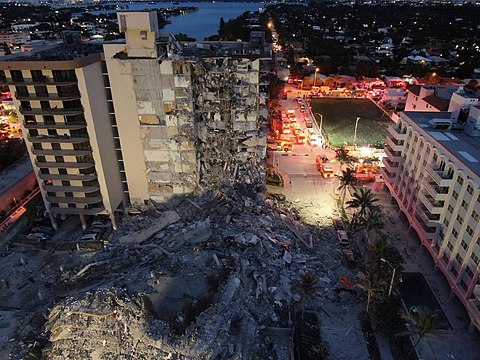JUNE 29, 2021 – Yesterday at noon I turned on our kitchen TV, selected CNN, and fixed myself a chicken sandwich. In his signature monotone, Wolf Blitzer led off from the site of the condo collapse in Florida. After 10 minutes, I realized there was no other news.
As I reflected on the horrific story of a building pancaking, killing probably over 160 people, I considered the multiple stories within the story.
The headline’s subhead: “No One Expected or Wanted It; No Storm or Earthquake Involved.” The slim odds (until it happens) of such an event and its sensational physical impact guarantee the status of “lead.”
Immediately under the main story is the heart-wrenching story of human loss—up to 160 deaths in one fell swoop, or rather, one swooping fall, comparable to the number of fatalities in a catastrophic plane crash. CNN goes to town on this one, combining emotionalism with sensationalism. “How do you feel not knowing whether your grandmother survived the building collapse?” (Gee, I wonder . . .)
As the question was asked and answered, I contrasted the story with chronic tales of our time: gun deaths approaching 39,000/year in America . . . more than motor vehicle deaths of 38,000/year but fewer than drug-overdose fatalities (70,000/year). Since those catastrophes are commonplace and involve unimaginable numbers, they aren’t newsworthy. Now there’s a story.
The story of human loss is inextricably bound to the story of heroism—first responders, search teams risking life and limb on behalf of potential survivors. What’s the psychological profile of a person who signs up for such duty? Another story.
Yet another: the nation’s crumbling physical infrastructure. Does the average citizen think that among all +40-year-old structures in this country, Champlain Towers was the only with big-time defects? If so, check out the many bridges and parking ramps—where structural compromise is far more visible but hardly isolated—in your area of settlement.
The “crumbling infrastructure” story is intertwined with the story of government regulation, inspection, and enforcement. Pro-government-regulation folks say, “This is why we need more government. Who else will impose building codes and inspection requirements, and enforce the same . . . and fund these efforts?” The anti-government people do what they always do—point to failure in one instance as “proof” that government “isn’t part of the solution; it’s part of the problem.” (Oh boy.)
Then there’s the causation story. This involves forensic engineering, finger-pointing, and stressful meetings—inside city council chambers; among REIT trustees and HOA board members; all over insurance companies. Meanwhile, across the Litigious States of America, herds of lawyers and infotainers will light the process afire. Fueling the fire will be demands for immediate answers. A culture that is so quick to shift blame and accountability for financial loss or pronounce guilt after a sensational crime is also the culture that will jump to conclusions when it comes to a complex of causal relationships. More than likely, a host of factors contributed to failure. To get the remedies right, we need get the causal relationships right.
(End of stories.)
(Remember to subscribe to this blog and receive notifications of new posts by email.)
© 2021 by Eric Nilsson
